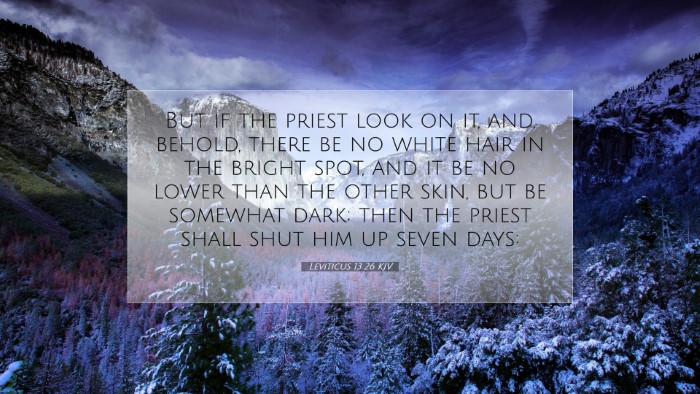Commentary on Leviticus 13:26
Leviticus 13:26 states:
"But if the priest look on it, and, behold, there be no white hair in the bald head, and it be not deeper than the skin, but be somewhat dim; then the priest shall shut him up seven days."
Contextual Overview
This verse falls within the larger body of laws concerning leprosy and other skin diseases, which are outlined in Leviticus 13. The chapter deals comprehensively with various forms of infection, their identification, and the prescribed rituals for purification. The presence of skin diseases in ancient Israelite society carries significant theological and social implications, often representing not only physical ailment but also moral and spiritual states.
Commentary Insights
1. Understanding the Diagnostic Role
Matthew Henry emphasizes the critical role of the priest as a diagnostician in matters of health and purity. The priest acts as a mediator between the person afflicted and God, indicating that healing and purity are not merely personal matters but communal ones. The determination of skin diseases required careful observation and discernment, which underscores the importance of spiritual vigilance in all areas of life.
2. The Symbolism of Leprosy
Albert Barnes posits that leprosy symbolizes sin and its effects on the body and soul. Much like sin can manifest in hidden ways, the symptoms described in the verse reflect the insidious nature of moral and spiritual decay. The phrase "somewhat dim" may indicate that the affliction was not fully developed, symbolically suggesting that unconfessed sin can start small but must be addressed before it escalates.
3. The Role of Observation
Adam Clarke notes the significance of the priest's observation of the skin condition, highlighting the importance of consistent monitoring of one’s spiritual and physical health. The act of “shutting up” implies a period of reflection and assessment, encouraging individuals to examine their inner life in light of God’s holiness.
Theological Implications
The examination by the priest can be viewed as a parallel to pastoral oversight in the church today. Just as the priest scrutinizes for subtle signs of disease, pastors are called to discern spiritual health within their congregations. Here are a few key theological reflections:
- Community and Accountability: The communal aspect of spiritual health is reinforced by the isolation suggested by the seven-day observation, which echoes the call for accountability among believers.
- The Nature of Sin: This verse illustrates the importance of addressing sin at its initial signs rather than allowing it to develop unchecked.
- Grace in Judgment: The period of isolation can be seen as a form of grace, allowing individuals time to reflect on their condition before a more serious action is taken.
Practical Applications
This verse offers multiple practical insights for pastoral care and personal discipline:
- Encouragement for Self-Examination: Believers should practice self-reflection and seek the guidance of spiritual leaders when confronted with moral dilemmas.
- The Importance of Community: Church communities should create safe spaces for individuals to discuss personal struggles without fear of condemnation.
- Cultivation of Spiritual Vigilance: Just as the priest observed the physical signs, spiritual care requires vigilance in recognizing signs of spiritual distress among congregants.
Conclusion
Leviticus 13:26 serves as a reminder of the interplay between physical health and spiritual wellness. Observers and leaders within the church today can learn much from the role of the priest as a careful examiner and guide. The application of these principles fosters an environment that encourages healing, accountability, and growth in faith.


